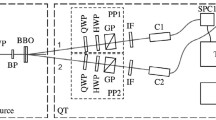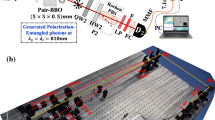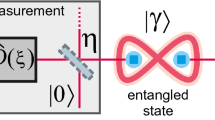Abstract
The process of quantum tomography of polarization-entangled photon pairs was simulated on quantum computers of different generations of the IBM Q Experience platform. The simulation was carried out for all four two-qubit Bell states. It turned out that the contribution of basis states that are absent in Bell states does not exceed 10\(\%\) even on quantum computers of the first generations, and is reduced to several percent on quantum computers of the latest generation. The simulation quality was evaluated using Fidelity. The Fidelity values were in a range of 68.6–94.9\(\%\), depending on the generation of computers. It was shown that for Bell states Fidelity can be calculated using three tomographic measurements instead of the nine required for determination of the density matrix using quantum state tomography.


Similar content being viewed by others
REFERENCES
T. D. Ladd, F. Jelezko, R. Laflamme, et al., Nature (London, U.K.) 464, 45 (2010).
J. Q. You and F. Nori, Nature (London, U.K.) 474, 589 (2011).
L. Gyongyosi and S. Imre, Comput. Sci. Rev. 31, 51 (2019).
Y. Zhou, E. M. Stoudenmire, and X. Waintal, Phys. Rev. X 10, 041038 (2020).
F. Arute, K. Arya, K. Babbush, et al., Nature (London, U.K.) 574 (7779), 505 (2019).
H. S. Zhong, H. Wang, Y. H. Deng, et al., Science (Washington, DC, U. S.) 370 (6523), 1460 (2020).
M. Kjaergaard, M. E. Schwartz, J. Braumьller, et al., Ann. Rev. Condens. Matter Phys. 11, 369 (2020).
H. L. Huang, D. Wu, D. Fan, et al., Sci. China Inf. Sci. 63, 180501 (2020).
R. Blatt and C. F. Roos, Nat. Phys. 8, 277 (2012).
C. D. Bruzewicz, J. Chiaverini, R. McConnell, and J. M. Sage, Appl. Phys. Rev. 6, 021314 (2019).
I. Beterov, Optoelectron. Instrum. Proc. 56, 317 (2020).
J. L. O’Brien, Science (Washington, DC, U. S.) 318 (5856), 1567 (2007).
P. Kok, W. J. Munro, K. Nemoto, et al., Rev. Mod. Phys. 79, 135 (2007).
R. Orus, M. Samuel, and E. Lizaso, Rev. Phys. 4, 100028 (2019).
S. McArdle, S. Endo, and A. Aspuru-Guzik, Rev. Mod. Phys. 91, 015003 (2020).
J. Zhang, G. Pagano, P. W. Hess, et al., Nature (London, U. K.) 551 (7682), 601 (2017).
V. Dunjko and P. Wittek, Quantum Views 4, 32 (2020).
P. Kim, D. Han, and K. Jeong, Quant. Inf. Proc. 17 (12), 339 (2018).
C. Sabin, Quant. Rep. 2, 208 (2020).
T. R. Bromley, J. M. Arrazola, S. Jahangiri, et al., Quant. Sci. Technol. 5, 034010 (2020).
https://qiskit.org.
S. Rahimi-Keshari, T. C. Ralph, and C. M. Caves, Phys. Rev. X 6, 021039 (2016).
M. Kapil, B. K. Behera, and P. K. Panigrahi, arXiv: 1807.00521 (2018).
J. Preskill, Quantum 2, 79 (2018).
B. Nachman, M. Urbanek, W. de Jong, et al., NPJ Quant. Inf. 6 (1), 1 (2020).
S. A. Magnitskiy, D. N. Frolovtsev, V. V. Firsov, et al., J. Russ. Laser Res. 36, 618 (2015).
D. N. Frolovtsev, S. A. Magnitskiy, and A. V. Demin, Meas. Tech. 63, 273 (2020).
R. Josza, J. Mod. Opt. 41, 2315 (1994).
ACKNOWLEDGMENTS
We thank professor V.M. Gordienko for support of the work and professor A.S. Chirkin for discussion of the results and helpful remarks.
Author information
Authors and Affiliations
Corresponding author
Additional information
Translated by E. Baldina
About this article
Cite this article
Manko, S.D., Frolovtsev, D.N. & Magnitsky, S.A. Simulation of Quantum Tomography Process of Biphoton Polarization States on a Quantum Computer. Moscow Univ. Phys. 76, 97–103 (2021). https://doi.org/10.3103/S0027134921020065
Received:
Revised:
Accepted:
Published:
Issue Date:
DOI: https://doi.org/10.3103/S0027134921020065




